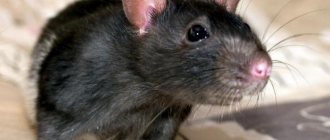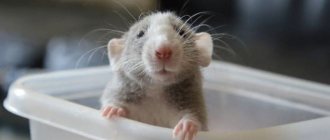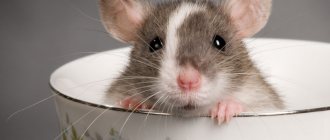Numerous studies have proven that rats are social animals. The pet will feel best in the company of its own kind. They can sleep together, play and compete for treats, and have fun in other ways.
Thanks to their active social life, these animals have developed a special behavior pattern. For example, they may groom each other and show aggression or affection. Such actions may remind them of times with their mother. The term "group grooming" indicates the high quality of life of the animals and their overall level of happiness.
Most rat owners note their friendliness and devotion. A number of owners notice their pets have an interesting way of licking a person’s hands upon contact. Opinions differ about why the pet performs such strange actions. Some believe that in this way the rat thanks the owner for the treat and care. Others believe that the animal’s interest is the very smell of the human body. But guesswork is just guesswork, and the true reason for this behavior will be interesting to know for all owners and lovers of rodents.
Why does a rat lick its fingers?
Owners of decorative rats often ask questions: Why does the rat lick its hands and lick its fingers?
The answer to these questions is clear: this is how your pet expresses his love and affection for you! Of course, any tame rat will gladly lick your hands if they smell delicious or are dirty with some kind of treat, for example, yogurt. But owners sometimes conduct “experiments” - they wash their hands with neutral soap, completely depriving them of any smell. And what? Cute rats still lick their owners' hands! And many even practice the so-called “biting”, gently moving their teeth between their fingers or elsewhere on their hands. This “ticklish” sensation is pleasant for the owner and is also an indicator of the rat’s tender attitude and true affection. Some rats “go” even further - they lick the owner’s ears, cheeks, and even “polish” the owner’s glasses. At the same time, not all rats are so loving - some begin to lick hands as soon as they are taken out of the cage, others - from time to time, others - never. It all depends on the individual character of each decorative rat and the degree of its attachment to its owner. And also from the “set” of affection that you personally give to the rat. For example, if the owner himself is not averse to stroking the pet, ruffling its fur, or gently blowing on its belly, then the rat will most likely reciprocate “completely.” Such “kissing” pets communicate with the owner very touchingly and licking, biting a person’s hands and ears are manifestations of complete trust and all-consuming love.
Article on the topic: Essay about a hamster in Russian (3 options for grades 1-5)
The answer to the question: why does a rat lick its hands can be obtained by turning to the peculiarities of the relationship between rats and their fellow tribesmen. In an ordinary family of rats, relationships are very clearly established - here you have a strict hierarchy, discipline, mutual assistance, and constant communication. “Caring for one’s neighbor” also occupies a large place in the rat community—it is customary for these tailed wizards to carefully care for each other’s fur coats, licking and biting them. This is the original manifestation of love and care in the animal world! Accordingly, if a decorative rat likes a person, then it will perceive him as “a member of his pack”, and the attitude towards the person will be appropriate - the rat will express tender feelings towards the person in the same way as towards its fellows. And since a person does not have a “fur coat,” the owner’s delicate skin will be used, on which your beloved rat will carefully “take out” all his care and love. Touching, isn't it?
How long does the addiction process take?
The process of habituation is individual for each animal. Some will be able to tame an animal in a few days, while others will be able to tame it in a month or more. It all depends on the nature of the animal and some other factors. But don’t expect him to climb into your arms or follow you around overnight.
Did you know? Three days
—record time for which a rat covered a water distance of 29 km.
Factors influencing the time it takes for a rat to get used to hands:
The younger the pet is, the faster it gets used to it. But don’t despair, even an adult rat can be trained to another owner. Breeder's attitude towards pups
If he exercises every day and pays attention to them, then they gradually become tamed to his hands. Such animals are very curious and are not afraid to even climb into your arms.
Otherwise, the kids will be half-wild, or even wild. But we should not forget about the personal qualities of a particular baby. Rats, like people, vary in character and temperament. Some are arrogant, harmful, others are loving, affectionate, and friendly.
In the first stages of taming, do not be afraid to bore your pet
By constantly paying attention to your little rat, you can get a friend who is very attached to his owner. Therefore, take your baby in your arms more often, wear it under outerwear, even if he shows his dissatisfaction.
Of course, do this within reason. If he resists strongly, then it is better to leave him alone today.
Did you know? Rat teeth grow throughout the animal's life, so rodents are not afraid to grind them down.
To pick up an unfamiliar rat, hold it from above, hugging its body with your hand; the other hand can support its hind legs and tummy. When you cover the animal with your palm and apply slight pressure, the little rat quickly calms down and does not offer resistance. The more often you play and are with your pet, the faster the addiction process goes.
Read also:
You can use various materials as a house for your beloved rat Lariska: cardboard, plywood, fabric, wood, plastic. Let's look at how to build your own home from a cardboard box.
The program “While Everyone is Home,” extremely popular in the 1990s, and its constant column “Crazy Hands” offered thousands of uses for an ordinary plastic bottle: a birdhouse, a waterer for flowers, a washbasin, and even plastic slippers for the garden. We suggest making a bedroom for your rat out of an unnecessary bottle.
All pet owners dream of their pet being healthy, happy, playful and living in love and comfort. The key to health and good mood is proper nutrition and good sleep. In this article we will talk about the last component.
Why does a rat lick itself?
On forums and resources in a question-and-answer format, you can find information from novice owners searching for information about why a rat licks their hands. Sometimes inexperienced “rat breeders” get scared, thinking that there is something wrong with them, or they assume that such habits are associated solely with the taste of food on their fingers.
Article on the topic: What is the difference between a mouse and a rat (photo) - comparison table
Symptoms that require you to contact your veterinarian
The help of a veterinarian is necessary when pathological causes are confirmed. They can be recognized by the following symptoms:
- increased salivation;
- weak cough, wheezing, blue mucous membranes and other signs of suffocation;
- prolonged refusal to eat, including the cat’s favorite treats;
- unpleasant odor from the mouth;
- abnormal stool (change in consistency and color, as well as the appearance of foreign matter);
- prolonged apathetic state and sleep disturbance;
- frequent or intense vomiting.
An accurate diagnosis can only be made based on tests, so do not rush to treat your pet with advertised drugs. Incorrect treatment can aggravate the situation, even leading to death.
A bit of animal psychology
It has been proven that the decorative rat is a social animal. Pets feel most comfortable in the company of other animals. They tend to sleep in a single ball, compete for treats, and simply play.
Life in society has shaped certain behavior patterns in rats. They touchingly care for each other, licking their tails and ears, combing their skin. Such actions are reminiscent of childhood, when the mother takes care of the babies. Group grooming means that the rat community is healthy, happy and experiencing only positive emotions.
Live rat
The traditional post is about pets.
We kept decorative rats in the past and really liked them for their intelligence and behavior. And so my wife and daughter again got a rat pet.
Meet the name - Meatball, my daughter tried hard to choose a name)
Very, very nimble, runs like lightning, but loves to sit on arms, on a shoulder or neck.
Unlike the rats that we used to have, he sits on our hands and licks them, we don’t know what kind of habit this is)
Relationship with the owner
Attachment to representatives
of its species - a distinctive feature that distinguishes the domestic rat. This means that they can transfer this behavior pattern to the owner who feeds and provides comfort.
When a rat licks the hands and hair of its owner, this indicates the rodent’s desire to care for a person. Most often, such an action is a response to scratching the cheeks and neck. Some individuals practice “biting”: they gently move their teeth and gently bite their fingers. This is an indicator of the animal’s true love and affection for its owner. A number of individuals move on, licking their cheeks, ears and trying to polish the glasses of their glasses until they shine.
Not every domestic rat licks itself. “Lovingness” depends on a number of factors:
- character of the animal;
- degree of love for the owner;
- the specifics of the owner’s interaction with the pet and the frequency of communication.
Article on the topic: How rats squeak and “talk”, the meaning of the sounds made
When a person has the desire and opportunity to devote significant time to the pet, ruffling the fur, stroking it, the rodent will begin to reciprocate and demonstrate complete trust and great love for the owner, enrolling him as a member of his own pack.
How long does the addiction process take?
The process of habituation is individual for each animal. Some will be able to tame an animal in a few days, while others will be able to tame it in a month or more. It all depends on the nature of the animal and some other factors. But don’t expect him to climb into your arms or follow you around overnight.
Did you know? Three days
—record time for which a rat covered a water distance of 29 km.
Factors influencing the time it takes for a rat to get used to hands:
The younger the pet is, the faster it gets used to it. But don’t despair, even an adult rat can be trained to another owner. Breeder's attitude towards pups
If he exercises every day and pays attention to them, then they gradually become tamed to his hands. Such animals are very curious and are not afraid to even climb into your arms.
Otherwise, the kids will be half-wild, or even wild. But we should not forget about the personal qualities of a particular baby. Rats, like people, vary in character and temperament. Some are arrogant, harmful, others are loving, affectionate, and friendly.
In the first stages of taming, do not be afraid to bore your pet
By constantly paying attention to your little rat, you can get a friend who is very attached to his owner. Therefore, take your baby in your arms more often, wear it under outerwear, even if he shows his dissatisfaction.
Of course, do this within reason. If he resists strongly, then it is better to leave him alone today.
Did you know? Rat teeth grow throughout the animal's life, so rodents are not afraid to grind them down.
To pick up an unfamiliar rat, hold it from above, hugging its body with your hand; the other hand can support its hind legs and tummy. When you cover the animal with your palm and apply slight pressure, the little rat quickly calms down and does not offer resistance. The more often you play and are with your pet, the faster the addiction process goes.
How to understand a decorative rat - tips for owners
How to understand decorative rats
Many pet owners complain that sometimes they don't understand what their pets are trying to say through their behavior. Now, if only you could learn to understand the language of cats (you can find useful tips here - they will help you learn to understand your cat), dogs and, of course, decorative rats - which are quite popular candidates for the role of a pet.
Our publication today will try to help you with this, and we will tell you how to learn to understand your decorative rat...
They are indestructible
This quality unites many movie monsters, especially serial ones: you kill them, you kill them, and by the time the next part comes out they are as good as new again.
Well, what do rats have to do with it, you ask. Common rodents. No hint of immortality. They can be anything they want, but considering them invincible is too much.
However... What is the surest way to kill a rat? I? So here it is. When rats find food they aren't sure is safe, they taste (.pdf) it first—just a little. And if they feel somehow wrong, they don’t touch this food again. They are well aware of our insidious plans and know how to destroy them.
In addition, we are increasingly faced with a completely new variety of these creatures, which scientists have already nicknamed “super mutant rats”, which are no longer affected by practically any poison.
Character of decorative rats
Rats are social rodents
If you think that all rodents have the same character, and they are all carbon-copy similar to each other in their behavior, you are mistaken. Just as there are no absolutely two identical people, there are absolutely no two identical decorative rats. And, this applies not only to their appearance, but also to their inner world. There are general behavioral features characteristic of the species, but each decorative rat has its own character.
It is quite obvious that when you come to a pet store and want to choose a pet, you still don’t know anything about it or its character. In order for you to make a first impression (which, however, can also be wrong), we suggest that you spend a few minutes of your time observing the behavior of the rat in its usual environment. How does she behave with her relatives, how does she eat, is she constantly on the move or does she prefer to sit in the corner of the cage? All this will allow you to get at least a general idea of the character of your future pet.
Article on the topic: How many years do decorative rats live at home?
So, if a decorative rat is nimble and active, most likely it will remain so. If the rodent behaves quietly, and you dreamed of such a quiet one, then, after making sure that the rat is not sick (quiet behavior may indicate the presence of hidden diseases, this should also not be forgotten - read more about their symptoms here), you can make a choice in her favor.
Diseases
Rat scratching is often a symptom of serious illness. Disorders of the liver and gastrointestinal tract, kidney damage, infections, viruses - can sometimes manifest themselves as itchy skin.
Typically, in this case, additional symptoms are observed - reddish discharge from the nose and eyes (porphyrin), restless behavior or lethargy, and bowel movements.
Various fungal diseases
the skin also causes severe itching.
If you notice your rat scratching its eye, conjunctivitis
.
Sometimes a rat may itch due to infestation with helminths
. Medicines for helminth infections are toxic, so it is not recommended to treat the animal without preliminary analysis. If infection is confirmed, it is necessary to calculate the dosage by weight with great accuracy.
If you want to know why your rat is constantly itching, it is better to contact a veterinarian for a professional examination and testing. Then you will be sure that you will not miss a serious illness, and the doctor will prescribe the correct treatment, taking into account the condition and age of the animal.
Previous Rat healthAntibiotics and drugs for domestic rats: use and dosage Next Rat healthFrequently asked questions on diseases of ornamental rats
Tips to help you understand the decorative rat
So, we have established that character is an individual characteristic of each individual. However, there are little clues that can help you understand any and all ornamental rats, even the sphinx rat. These clues are some common behaviors that, once you learn to recognize, will help you understand your rodent without words.
Why does a rat lick its owner's fingers or hair?
A person who is far from keeping such rodents at home will not think long about the answer to this question. Yes, she's just hungry and wants to eat you. But that's not true. The fact is that decorative rats are very social and social pets. And, if Djungarian hamsters are rather self-sufficient creatures that simply tolerate your company and your attention, then decorative rats, on the contrary, enjoy your attention and your touches, and in order to somehow express their gratitude to you - they try to lick your fingers and hair. This rat “grooming” reminds them of childhood and maternal affection, and in such a situation, they show you that they treat you as tenderly and affectionately as a mother treats her cubs. This is exactly how they show their care to us.
Article on the topic: Skeleton and anatomy of the rat, internal structure and location of organs
The same can be said about situations when you watch rats lick each other, stroke each other’s tails, noses, ears...
Considering this peculiarity of the behavior of rats, if you cannot give your rodent enough attention, so that he does not die from melancholy and loneliness, which rats tolerate very poorly, it is recommended to get him a mate with whom he can fully realize his needs in communication. Well, you will definitely enjoy watching how decorative rats sleep in an embrace, play and playfully fight... Read more about breeding decorative rats at home.
Why does a rat grind its teeth?
Wary behavior of a decorative rat
You can often hear owners of decorative rats say that their pet periodically grinds its teeth. Most often this happens when you pick up a rodent and it sits on your shoulder, however, a similar squeak can be heard under other circumstances. What does it mean? Does the rat express dissatisfaction in this way, or, on the contrary, show how happy it is? In order to characterize the hidden meaning of teeth grinding in rats, we invite you to remember why cats purr. In this way, your pet shows you how happy and glad he is that he has you, that you feed him and take care of him. During such a squeak, a vibration occurs that passes through the entire body of the decorative rat, and it may even begin to tremble with joy.
However, if a rat does not just grind its teeth with happiness, but clicks them, then this is already a state of excitement and excitement. Something scared or interested your pet, and if he could talk, he would definitely tell you about it.
Article on the topic: Can rats swim (wild and domestic)?
If the clicking of the teeth is accompanied by such signs as the fur on the back standing on end, tension throughout the body, the shine of the eyes, while the rat looks, staring at one point, then this is already a strong excitement, caused by an emotion of a negative nature. If the hissing and squealing sounds that the rodent makes are added to the picture described above, then it is preparing for an attack.
If you observe a similar picture in a cage with several rats, it is better to temporarily put the most aggressive one in another cage so that it can calm down and let off steam, since in this state it is ready for a rat fight to the death.
Why do rats fight each other?
In the animal world, as in the human world, there is a hierarchy, at the top of which there is a dominant, who constantly has to remind everyone else of this. The world of rats and your mini rat colony also have their own hierarchy, and here all the roles, functions, responsibilities and rights of each participant in such a habitat are clearly distributed. Therefore, trying to completely control the behavior of animals and interfere in all their disputes is not worth it, and it is not very correct. In any case, among your rodents there must be one most important one, and he will need to prove his importance with the help of his strength. Therefore, if you witness a rat fight (we are not talking about a bloody massacre when animal fur flies into different corners of the cage), you should not interfere in it. As a rule, it all begins with ritual sniffing, squealing (these are more exclamations of encouragement and intimidation of one’s opponent than real threats and rage), and ends with a short struggle, as a result of which the weak rodent ends up laid on the floor of the cage. This is how the dominant and the most important rat is determined.
Related article: Can rats laugh? Video of a laughing rat
If you notice that the determination of primacy turns into bloodshed, it is better to try to separate the rats and seat them in different cages until they calm down. By the way, at this moment, be careful, even the most tame rat, in the heat of its mood, can forget about how much it loves you and inadvertently bite your finger or even slip out of your hands.
How about a kiss?
In the small rented one-room apartment, there are rats everywhere. Live and in pictures, wallpaper, portraits, in the form of toys, and also on the bike in which Andrey meets us. Pets appeared in his life six years ago: “I wanted to get some kind of animal.” The cats are on my mind, the dog needs to be walked, but with work and school there was no time left for this. In general, the rat turned out to be an ideal option. My girlfriend and I began to study information on care, feeding, treatment, and learned that it is necessary to keep not just one animal, but at least a couple, because the animal does not tolerate loneliness well. So over time we got rats.
The wards have very different characters, but they all love their owner equally.
Candy, Paparats-kvetka, Shkvarochka, Curl-Cheburunka, Don Simon... The wards have very different characters, but they all love their owner equally reverently. As soon as he approaches the cage, curious noses immediately poke out, and Andrei is ready to kiss each animal:
– Like any creatures, rats love affection and care. It is better to stroke them behind the ears, on the cheeks and chin; some let them scratch their bellies. But it’s better not to grab someone’s back; it can be perceived as aggression. These are brave and very smart animals - if not for their intelligence, these peers of dinosaurs simply would not have survived. Many people shy away from rats, forgetting that they served as the basis for various scientific discoveries and achievements. Rats also know how to empathize; they understand by the timbre of their voices when you are upset or sick, and they try to feel sorry for you. They themselves will not show their weakness until the very end. You can understand that a pet is not feeling well only when it is already completely unbearable. At such a moment, you need to drop everything and rush to the veterinary hospital, otherwise you risk losing your friend.











